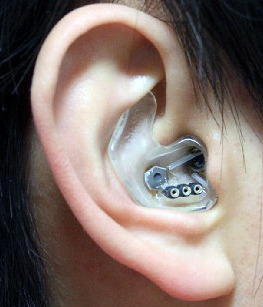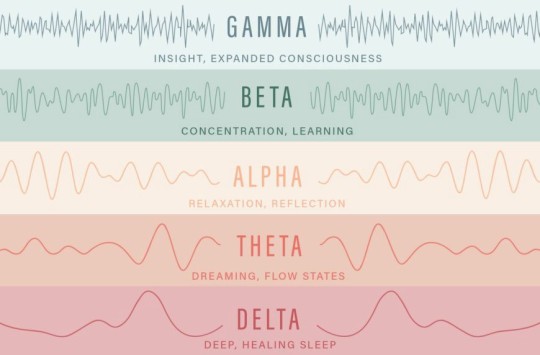#brainwaves
Neuroscientists often use electroencephalography (EEG) as an inexpensive way to record electrical signals in the brain. Though it would be useful to run these recordings for long periods of time, that usually isn’t practical: EEG recording traditionally involves attaching many electrodes and cables to a patient’s scalp.
Now engineers at Imperial College in London have developed an EEG device that can be worn inside the ear, like a hearing aid. They say the device will allow scientists to record EEGs for several days at a time; this would allow doctors to monitor patients who have regularly recurring problems like seizures or microsleep.

“The ideal is to have a very stable recording system, and recordings which are repeatable,” explains co-creator Danilo Mandic. “It’s not interfering with your normal life, because there are acoustic vents so people can hear. After a while, they forget they’re having an EEG.”
By nestling the EEG inside the ear, the engineers avoid a lot of signal noise usually introduced by body movement. They can also ensure that the electrodes are always placed in exactly the same spot, which, they say, will make repeated readings more reliable.
Since the device attaches to just one area, it can record only from the temporal region. This limits its potential applications to events that involve local activity. Tzzy-Ping Jung, co-director of the University of California, San Diego’s Center for Advanced Neurological Engineering, says that this does not mean the device will not be valuable.
“Different modalities will have different applications. I would not rule out the usefulness of any modalities,” says Jung. “I think it’s a very good idea with very promising results.”
Let’s get Scientific: Reality is Energy
Source: A Metaphysical Guide to Meditation, Magick & Manifestation (CH. 1)
In the nature of physics, everything that seems solid is merely energy vibrating at a slower rate. Examined at microscopic levels, solid matter is made up of particles that are perpetually in motion.
Everything we can touch, hear, see, taste, and smell is simply energy in different forms being perceived by our senses- but not limited to what we can measure with our senses.

We cannot perceive or see all energy around us. Magnetic fields, radiation, and ultraviolet light are examples. Animals, however, possess more ability to hear and see things the common human can’t.

Source: Brainworks
At the root of all our thoughts, emotions and behaviors are the communication between neurons within our brains. Brainwaves are produced by synchronized electrical pulses from masses of neurons communicating with each other.
Each brainwave state is named after a Greek letter and is measured by the cycles per second called hertz.
The five brainwave states: gamma, beta, alpha, theta, and delta. By learning to alter our brainwave states we learn to alter our consciousness.
- GAMMA WAVES (38 TO 42 HZ):
Gamma brainwaves are the fastest of brain waves (high frequency, like a flute), and relate to the simultaneous processing of information from different brain areas. Gamma brainwaves pass information rapidly and quietly. The most subtle of the brainwave frequencies, the mind has to be quiet to access gamma.
Gamma was dismissed as ‘spare brain noise’ until researchers discovered it was highly active when in states of universal love, altruism, and the higher virtues. Gamma is also above the frequency of neuronal firing, so how it is generated remains a mystery. It is speculated that gamma rhythms modulate perception and consciousness and that a greater presence of gamma relates to expanded consciousness and spiritual emergence
____________________________
- BETA WAVES (12 TO 38 HZ):
Beta brainwaves dominate our normal waking state of consciousness when attention is directed towards cognitive tasks and the outside world. Beta is a ‘fast’ activity, present when we are alert, attentive, engaged in problem-solving, judgment, decision making, or focused mental activity.
Beta brainwaves are further divided into three bands; Lo-Beta (Beta1, 12-15Hz) can be thought of as a 'fast idle, or musing. Beta (Beta2, 15-22Hz) is a high engagement or actively figuring something out. Hi-Beta (Beta3, 22-38Hz) is a highly complex thought, integrating new experiences, high anxiety, or excitement. Continual high-frequency processing is not a very efficient way to run the brain, as it takes a tremendous amount of energy.
_____________________________
- ALPHA WAVES (8 TO 12 HZ):
Alpha brainwaves are dominant during quietly flowing thoughts and in some meditative states. Alpha is the power of now, being here, in the present. Alpha is the resting state of the brain. Alpha waves aid overall mental coordination, calmness, alertness, mind/body integration, and learning.
____________________________
- THETA WAVES (3 TO 8 HZ):
Theta brainwaves occur most often in sleep but are also dominant in deep meditation. Theta is our gateway to learning, memory, and intuition. In theta, our senses are withdrawn from the external world and focused on signals originating from within. It is that twilight state which we normally only experience fleetingly as we wake or drift off to sleep. In theta, we are in a dream; vivid imagery, intuition, and information beyond our normal conscious awareness. It’s where we hold our ‘stuff’, our fears, troubled history, and nightmares.
____________________________
- DELTA WAVES (.5 TO 3 HZ):
Delta brainwaves are slow, loud brainwaves (low frequency and deeply penetrating, like a drumbeat). They are generated in deepest meditation and dreamless sleep. Delta waves suspend external awareness and are the source of empathy. Healing and regeneration are stimulated in this state, and that is why deep restorative sleep is so essential to the healing process
____________________________
Upcoming Topics:
- Binaural Beats
- Pineal Gland
